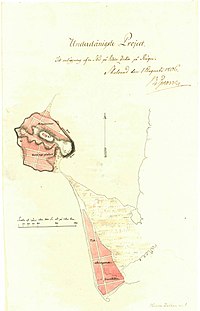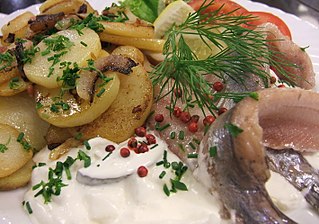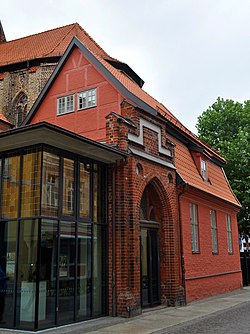
Mecklenburg-Vorpommern, also known by its anglicized name Mecklenburg–Western Pomerania, is a state in the north-east of Germany. Of the country's sixteen states, Mecklenburg-Vorpommern ranks 14th in population, It covers 23,176 km2 (8,948 sq mi) making it the sixth largest German state in area, and 16th in population density. Schwerin is the state capital and Rostock is the largest city. Other major cities include Neubrandenburg, Stralsund, Greifswald, Wismar and Güstrow.

Stralsund, officially the Hanseatic City of Stralsund, is a city in the Pomeranian part of Mecklenburg-Vorpommern, Germany. It is located at the southern coast of the Strelasund, a sound of the Baltic Sea separating the island of Rügen from the mainland.

Rügen is Germany's largest island. It is located off the Pomeranian coast in the Baltic Sea and belongs to the state of Mecklenburg-Western Pomerania.

Nordvorpommern was a Kreis (district) in the northern part of Mecklenburg-Vorpommern, Germany. It was situated at the coast of the Baltic Sea, where it enclosed the city of Stralsund. Further to the northeast, separated from Stralsund and Nordvorpommern by the Strelasund, lies the island of Rügen, administratively part of the eponymous district. Other neighboring districts are Ostvorpommern, Demmin, Güstrow and Bad Doberan.

Ribnitz-Damgarten is a town in Mecklenburg-Vorpommern, Germany, situated on Lake Ribnitz. Ribnitz-Damgarten is in the west of the district Vorpommern-Rügen.

Swedish Pomerania was a Dominion under the Swedish Crown from 1630 to 1815, situated on what is now the Baltic coast of Germany and Poland. Following the Polish War and the Thirty Years' War, Sweden held extensive control over the lands on the southern Baltic coast, including Pomerania and parts of Livonia and Prussia.

Barth is a town in Mecklenburg-Vorpommern, Germany. It is situated at a lagoon (Bodden) of the Baltic Sea facing the Fischland-Darss-Zingst peninsula. Barth belongs to the district of Vorpommern-Rügen. It is close to the Western Pomerania Lagoon Area National Park. In 2011, it held a population of 8,706.

Franzburg is a municipality in the Vorpommern-Rügen district of Mecklenburg-Vorpommern, Germany. It is situated 20 km southwest of Stralsund. Before the Protestant Reformation, later Franzburg was the site of Neuenkamp Abbey.

Prerow is a municipality in the district of Vorpommern-Rügen in the German state of Mecklenburg-Vorpommern. This Baltic seaside resort on the Darß peninsula is located about halfway between the historic Hanseatic towns of Rostock and Stralsund. It is one of three main settlements on the Darß, the others being the villages of Born and Wieck. Prerow has fine, sandy beaches and a picturesque landscape. It is hard to say where the forest ends and the village begins. The primeval Darß Forest has over 50 km of footpaths and cycle ways, a bridleway and tracks for horse-drawn carriages. West of the forest is West Beach with rugged terrain formed by wind and waves. South of Prerow is the bodden countryside. Visitors can take trips on a steam paddle boat and experience wildlife first-hand, nesting areas and various birds as the seasons change.

The Principality of Rügen was a Danish principality, formerly a duchy, consisting of the island of Rügen and the adjacent mainland from 1168 until 1325. It was governed by a local dynasty of princes of the Wizlawiden dynasty. For at least part of this period, Rügen was subject to the Holy Roman Empire.

The Pomeranian State Museum in Greifswald, Western Pomerania, is a public museum primarily dedicated to Pomeranian history and arts. The largest exhibitions show archeological findings and artefacts from the Pomerania region and paintings, e.g. of Caspar David Friedrich, a Greifswald local, such as Ruins of Eldena Abbey in the Riesengebirge. The museum was established in the years of 1998 to 2005 at the site of the historical Franziskaner abbey.

Gustavia was a 19th-century unfinished Swedish town on the island of Rügen, the construction of which began and had to be aborted during the Napoleonic Wars.
Vorpommern-Rügen is a district in the north of Mecklenburg-Vorpommern, Germany. It is bounded by the Baltic Sea and the districts Vorpommern-Greifswald, Mecklenburgische Seenplatte and Rostock. The district seat is the Hanseatic city of Stralsund.

Barnim VIII, Duke of Pomerania was Duke of Pomerania–Wolgast–Barth.

Pomeranian cuisine generally refers to dishes typical of the area that once formed the historic Province of Pomerania in northeast Germany and which included Stettin and Further Pomerania. It is characterised by ingredients produced by Pomeranian farms, such as swede (Wruken) and sugar beet, by poultry rearing, which has produced the famous Pomeranian goose, by the wealth of fish in the Baltic Sea, rivers and inland lakes of the Pomeranian Lake District, and the abundance of quarry in Pomeranian forests. Pomeranian cuisine is hearty. Several foodstuffs have a particularly important role to play here in the region: potatoes, known as Tüften, prepared in various ways and whose significance is evinced by the existence of a West Pomeranian Potato Museum, Grünkohl and sweet and sour dishes produced, for example, by baking fruit.

The Region of Stralsund belonged to the Prussian Province of Pomerania and existed from 1818 to 1932.

Historical Western Pomerania, also called Fore Pomerania, Front Pomerania or Hither Pomerania, is the western extremity of the historic region of Pomerania forming the southern coast of the Baltic Sea, Western Pomerania's boundaries have changed through the centuries as it belonged to various countries such as Poland, the Duchy of Pomerania, Sweden, Denmark, as well as Prussia which incorporated it as the Province of Pomerania.
New Western Pomerania was that part of Western Pomerania that went to Prussia under the terms of the Congress of Vienna in 1815.

The Stadtarchiv Stralsund is the historical Archive of the Hanseatic City of Stralsund and an important municipal archive in Mecklenburg-Vorpommern.
Jaromar II, Prince of Rügen was a Slavic nobleman. He was the ruling Prince of Rügen from 1249 until his death.



















